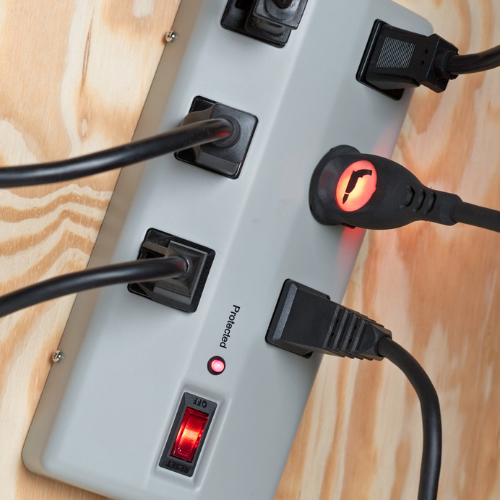Home / Electrical / Surge Protectors
Protect Your Power in the Rio Grande Valley
Whole-Home Surge Protection & Surge Protector Installation
Power spikes from lightning, utility switching, and large appliances can quietly damage electronics, HVAC, and smart gear. Treviño Repairs installs panel-mounted surge protective devices (Type 1/Type 2 SPDs) at your main panel (and subpanels when needed), pairs them with point-of-use protection for sensitive equipment, and verifies the essentials—grounding/bonding, breaker sizing, short lead lengths, and clear labeling—for code-compliant, reliable defense. Expect clean workmanship, testing, and a neat finish that helps safeguard your RGV home or business from costly surge damage.

Layered Defense Across the RGV
Services for Whole-Home Surge Protection
Treviño Repairs designs and installs surge protection that shields your entire electrical system—at the panel and at critical equipment. We review your service size and panel space, verify grounding/bonding, choose the right SPD type (Type 1 or Type 2) and kA rating, and install with short, straight leads and proper overcurrent protection for best performance. We can also add point-of-use protection and coordinate with generators, EV chargers, and sensitive electronics—clean, code-compliant, and neatly labeled for your Rio Grande Valley home or business.
We install & replace:
- Panel-mounted SPDs (Type 1 / Type 2) at main panels
- Subpanel SPDs (shops, additions, detached garages)
- Dedicated-equipment protection for HVAC condensers, mini-splits, well pumps, fridges/Freezers, openers
- Point-of-use protectors and UPS recommendations for office/AV gear
Code items & best practices (as applicable):
- Grounding & bonding upgrades; verify neutral/ground separation in subpanels
- Correct breaker sizing or line-side connection per device listing
- Short lead lengths, straight runs/twisted conductors, tidy routing
- Outdoor-rated enclosures (NEMA 3R) and clear labeling/status indication
Integration & coordination:
- Panel space planning or panel upgrades when needed
- Coordination with ATS/generator, EV charger circuits, and solar/ESS equipment
- Whole-home surge + AFCI/GFCI compatibility checks
Inspection & maintenance:
- Post-event SPD status checks and replacements when indicators trip
- Annual visual inspection and documentation for your records
How Whole-Home SPDs Work (and What They Don’t)
Electrical surges come from lightning, utility switching, and even large motors in your home (AC, well pump) kicking on and off—brief spikes that can weaken electronics and HVAC gear over time. A whole-home surge protective device (SPD) at your main panel clamps those spikes and shunts them safely to ground; performance depends on solid grounding/bonding, correct breaker or line-side connection, and short, straight leads to keep impedance low. For sensitive gear (computers, TVs, networking), add point-of-use protection or a UPS as a second layer—think of it as “panel defense + local defense.” Choose the right SPD type (Type 1/Type 2) and kA rating for your service, and check the status indicator after big storms—some SPDs sacrifice themselves and must be replaced. Note: SPDs don’t regulate voltage or fix sags/brownouts; they work alongside proper wiring, AFCI/GFCI protection, and good maintenance to protect your Rio Grande Valley home or business.

Know the Warning Signs in the Rio Grande Valley
When to Add or Upgrade Whole-Home Surge Protection
If you’ve lost electronics after storms, had HVAC or fridge control boards fail, see routers/NVRs or garage openers reboot randomly, or rely on sensitive gear (smart systems, home office, EV charger), you’re a strong candidate for a panel-mounted SPD. Other cues: your panel has no surge device, you’re upgrading the panel or adding a generator/EV/solar, or the surge protector’s status light is off/red after a lightning event (many SPDs sacrifice themselves and must be replaced). Treviño Repairs can verify grounding/bonding, choose the right Type 1/Type 2 and kA rating, install with short, straight leads and proper overcurrent protection, and coordinate with ATS/EV/solar—leaving your RGV home or business with layered, code-compliant surge defense.
What to Expect with Treviño Repairs
Our Lighting Installation & Upgrade Process
Assess & Select. Review service size, panel space, sensitive equipment, and choose the correct Type 1/Type 2 SPD and kA rating.
Protect & Power Down. Lay drop cloths, identify circuits, and safely de-energize with lockout/tagout; verify absence of voltage.
Prep Panel & Grounding. Check grounding/bonding and neutral–ground separation in subpanels; correct deficiencies for proper SPD performance.
Mount & Route. Install the SPD at the main panel or subpanel, using short, straight leads and tidy routing (NEMA 3R enclosure outdoors).
Connect & Secure. Make a listed breaker or line-side connection, size the breaker correctly, torque to spec, and coordinate with generator/EV/solar equipment.
Test & Label. Restore power, verify SPD status lights, label the device and breaker, and document install date and kA rating for your records.
Clean Up & Walkthrough. Tidy the workspace and review indicator meanings, replacement after major events, and optional point-of-use protection—so your RGV property has layered, code-compliant surge defense.

Real Stories. Real Results.
What Our Customers Are Saying
EXCELLENTTrustindex verifies that the original source of the review is Google. Very professional. Got the job done very quickly. Would definitely recommend.Posted onTrustindex verifies that the original source of the review is Google. Very professional and answered all questions I asked. Will call again if I have other electrical problems.Posted onTrustindex verifies that the original source of the review is Google. Great Service: We had a leak and couldn’t figure out where it was coming from. Eduardo took his time to find the source, kept me updated throughout the process, and finally discovered it was an AC leak. Just last week, we had paid another company to fix the same issue, but they didn’t do the job correctly. Eduardo explained everything clearly, offered to correct the problem, and even charged less than what we had previously paid the other company. Once he identified the leak, he made sure it was completely taken care of. I called today, and they arrived in less than an hour—excellent service! Eduardo was the best, and I highly recommend him company.Posted onTrustindex verifies that the original source of the review is Google. Great service, super fast and convenient. Valente came out same day, identified the problem in minutes, and built a solution in less than an hour. We appreciated that he provided options and up front pricing.Posted onTrustindex verifies that the original source of the review is Google. Had an electrical issue and called so many electricians. None were available and some didn’t answer at all or return calls. Called Treviños Plumbing, Electric, and HVAC and they scheduled us right away. Our technician, David, was very professional, friendly, patient, and fixed the issue! Great service! Thank you so so much! Highly recommended!!! Hopefully we won’t have any other issues for a while but if we do, I’m definitely contacting Trevino’s!Posted onTrustindex verifies that the original source of the review is Google. Great work by Eduardo, explained the problems thoroughly and fixed them quicklyPosted onTrustindex verifies that the original source of the review is Google. Had an emergency with my water pipe outside of my home. From what started with a leak water would not stop running, ended up being a whole fountain.(Water everywhere). Super panicked I call Trevino’s and they came to the rescue as quick as possible. So grateful and thankful for David D, he took our call and fixed our issue. Super fast service and arrival time 5 stars all the way. Thankyou so much.Posted onTrustindex verifies that the original source of the review is Google. Lee cordero from brownsville tx.This company went above and beyond for my dad.We called 3 other companys that were no show.This company is the best and they really work with your schedule and there super affortable and take there time to do the best work possible. My dad a vet and he has been dealing with this ac issue for months this company and there techos took there time for my dad when no else did hands of best company to go with .I highly recommend them .Thank you Tervino team. Antonio finally put my family at ease with this ongoing issue that no one else could figure out.Posted onTrustindex verifies that the original source of the review is Google. 5 stars, fantastic service! I will only hire this company from now on!!!!Posted onTrustindex verifies that the original source of the review is Google. Jiovanni, came by today for a call back at our house. He was pleasant professional, and quickly took care of the problem. We were very impressed with the service and the company. I praise God for the quick response, thank you again!Verified by TrustindexTrustindex verified badge is the Universal Symbol of Trust. Only the greatest companies can get the verified badge who has a review score above 4.5, based on customer reviews over the past 12 months. Read more
Surge Protector Questions, Answered
Straightforward answers before you book—symptoms, costs, fixes.
If I already use power strips, do I still need a whole-home surge protector?
Yes. Power strips are point-of-use protection. A panel-mounted SPD clamps large surges at the service, while strips/UPS units protect sensitive gear locally. The best setup is layered defense.
What’s the difference between Type 1 and Type 2 SPDs?
Type 1 can be connected on the line side of the main breaker (service entrance). Type 2 installs on the load side at the panel. We select based on your service, equipment listing, and panel space—often adding SPDs at subpanels serving HVAC, offices, or garages.
Will a surge protector stop lightning damage?
No device guarantees protection from a direct strike, but a properly installed SPD with good grounding/bonding and short lead lengths greatly reduces damage from indirect lightning and utility/appliance surges.
Does a whole-home SPD regulate voltage or lower my bill?
No. SPDs are passive until a spike occurs; they don’t fix sags/brownouts or improve efficiency. For sensitive electronics, pair the SPD with UPS/line conditioning at the device.
How long do SPDs last—and how do I know it’s time to replace one?
Many SPDs sacrifice themselves on big events. Check the status indicator after storms; if it’s off/red, replace the unit. We recommend an annual visual check and replacement per manufacturer guidance or after a major surge event for your RGV home or business.




